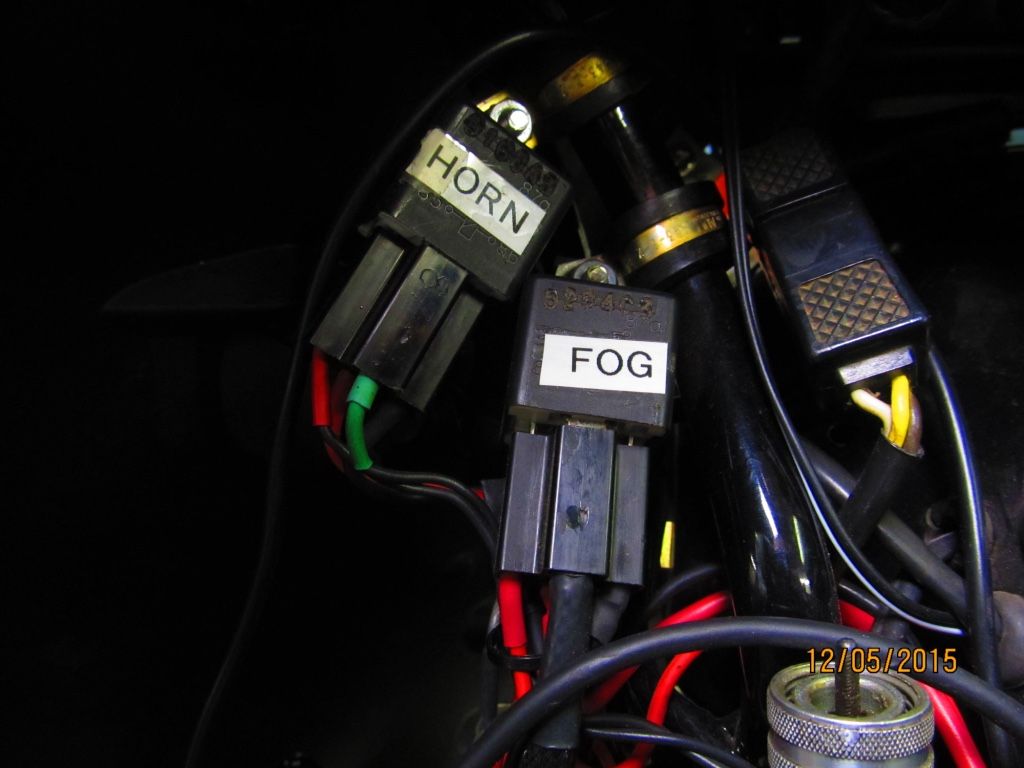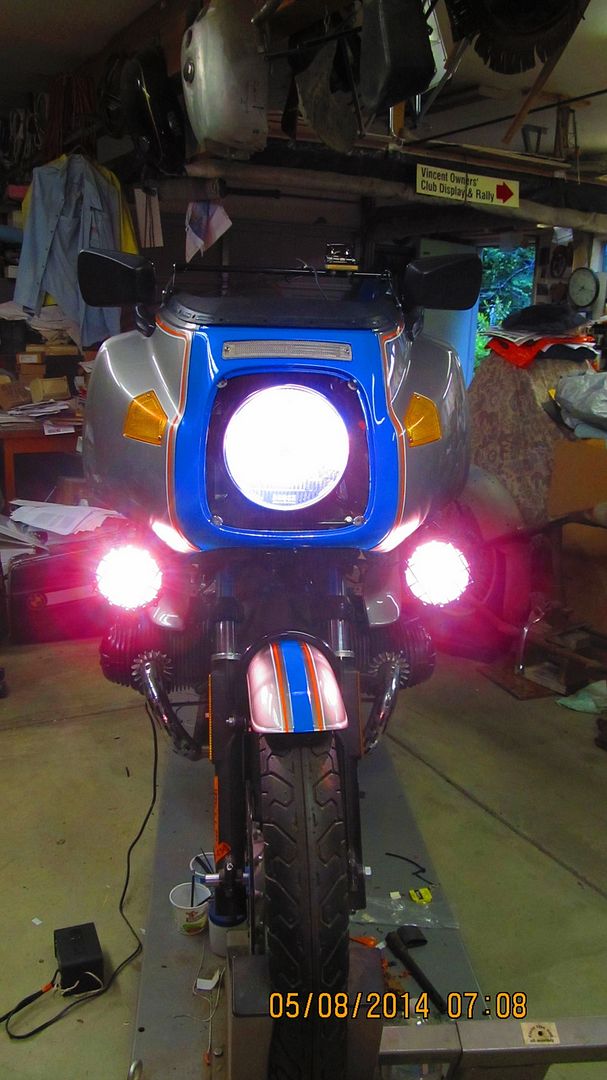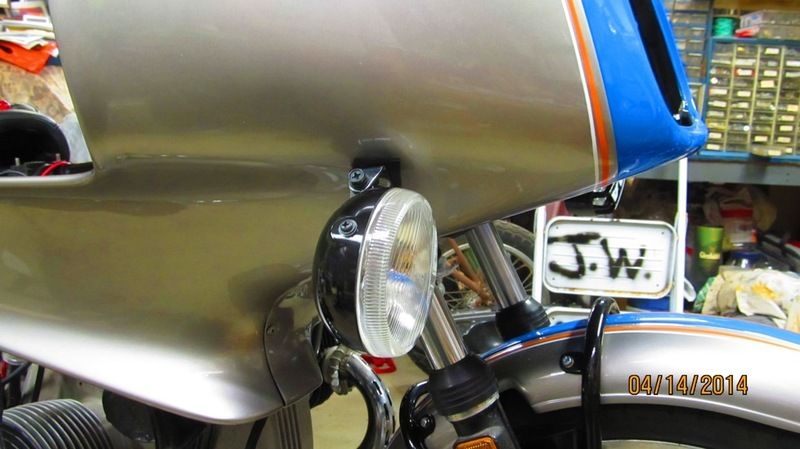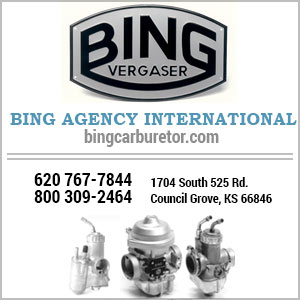upgrade lighting
I would like to upgrade the headlight on my 1983 100RT. brighter bulb? Can anyone recommend a solution and/or potential hazards?
I would, Upgrade the wires that feed voltage to the relay and headlamp circuit board and to the key switch first. heck you may even as I did add an aux 6 position 'fuzzblock' fuse panel.
> ----- >> Clean your ground wires and or ALL connections to the lighting components. Adding a separated 'brown' [= bmw color for gnd. ] ground wire from the H/L shell ensures loss of ground connection.
If the H4 bulb is of higher wattage then, because its behind a H/L glass & fairing glass [RS / RT / faired type ] will run the internal temp of your H/L shell hotter. This may effect other wires / components inside your headlamp.
So what's really needed here. Brighter lamps? How about a properly wired aux. (relay, switch, sized wire for components, solid mounts) system mounted off your fairing? Is your alt stock? That's something else to consider, especially if you run other electrical items (vest and electronics or a small camera/ go-pro battery charger, sound system/ iPod, etc.) and now a new light(s).
But the key first is to make sure your electrical system is working 98-100%. then upgrade the wiring to a heavier gauge wire for current draw. then when you DO upgrade your bike's alternator system it's very capable of whatever items you wish to apply to it. heated jacket, aux lighting, charging camera/ cel phone batteries while riding, GPS operation etc......
makes sense, just had'nt thought about that venue. where to put them etc.
 You can google ADV photos of R100RS bikes. there may be some ideas there or elsewhere.
You can google ADV photos of R100RS bikes. there may be some ideas there or elsewhere.
You can fabricate ::
> a flat tab in between the upper and side lower fairing. but that's just plastic/ glas holding an extension of weight and 4-8'' . Remember it has to hold the weight of the lamp set during or on rough, potholes, gravel, etc roads.
> off the crash bars.
> off the fork sliders having a new bracket set made.
> or do as i did and fabricate additional support structures off the main fairing head stock frame. ALL the above suggestions and more, just to add lamps for more visibility to aging eyes.
You might consider LED as aux lamps, they draw less current. make sure you get lighting that's 4300-5000 Kelvin. pure WHITE light. anything above 5400 or below 4000K will change the light's color to yellow or blue and then some.
it's a whole thought process to an end idea. all these things connect. these bikes were made 30+ yrs ago with a limited amount of Alternator output for point /hall trigger systems . these ideas add additional stress to frame and electrical systems while providing riders comfort.
I made my own wiring harness w/ relays to operate the Piaa 510's shown here.


All the above suggestions are true and good. But the place to start is to make sure your present system is working 100% before you upgrade anything. Obviously, you could spend lots of money upgrading the bulb wattage and adding relays, but if the original equipment is only working at 80%, then new add-ons won't be working up to full potential either.
My 1979 R100 had numerous connectors with corrosion on them. In fact the horns didn't even work. It's simply a result of 35+ years of water and humidity doing its work on brass connectors inside the HL shell and under the fuel tank. My corrective action, which cured all my electrical problems, consisted of individually unplugging every connector and relay and adding "electrical grease". The product I used is called "No-Ox" and is available on Ebay and Amazon. No-Ox is no ordinary grease; it is not a lubricant. It is a specially formulated paste to inhibit corrosion on electrical connections and prevent the oxidation caused by water. This stuff really works and it takes only the smallest amount, about the same volume as a match head, per contact. So the smallest $2 tube is enough for 20 motorcycles.
When this work was completed, my headlamp was brighter, my horns started working, and my battery voltage stabilized. So this action is highly recommend as your first step. Even if you do end up adding higher wattage bulbs, you need a good foundation to build upon.
Hope this helps.
Owning an old Airhead is easy.
Keeping an old Airhead running great is the true test.
I'm new on this board - so please forgive me if I'm making a protocol or procedure error in replying here. (And please advise me how to do it properly!)
I have an '84 R100RS and an '87 K100RS - both with H4 headlight bulbs.
In both cases I installed "headlight relays" to improve bulb brightness.
Headlight relays work by employing a relays as high quality (low resistance) switches that allow the bulb to be powered directly from the battery - ensuring full voltage to the bulb. I've read that small drops in voltage due to old and dirty switchgear and wiring connections can provide significant reduction in bulb brightness. I don't know how one might measure this, but both my bikes provide pretty good illumination with the relays.
The relays are available in "kit" form - I've used the ones from Eastern Beaver.
http://www.easternbeaver.com/Main/Wiring_Kits/H4_Kits/h4_kits.html
Some additional notes:
1) Relays like this are used in other places where the device such as the horn requires too much current for a simple switch on your handlebar.
2) The solenoid on your starter is doing the same thing as a relay - just much, much bigger.
3) The Eastern Beaver kits are available in several forms - but typically install by moving the headlight bulb connector to a connector on the kit, plugging the kit's connector to the headlight bulb, and connecting leads to your battery terminals. It's a very easy installation.
4) On my K100RS, I decided to clean up the wiring (less bulky) by making my own wiring that connects the relays directly into the bike's wiring harness. I'll probably do the same on my R100RS eventually.
5) Back in the 80's my buddies and I would use "illegal" higher wattage H4 bulbs in our bikes for brighter headlights. As I recall, these bulbs had the same wattage low beam filament, but a higher wattage high beam. I recall that these bulbs were expressly illegal in Europe and a grey-area in the USA. They would probably overheat stock wiring, but would be OK with upgraded wiring with relays. If I were going to do cross country night riding and couldn't add additional lights to the bike, I'd probably consider this option today.
J.S.
I'm new on this board - so please forgive me if I'm making a protocol or procedure error in replying here. (And please advise me how to do it properly!)
Welcome aboard! And thanks for the valuable contribution.
Your only error was in not submitting it earlier !! 😆
Cheers.
Owning an old Airhead is easy.
Keeping an old Airhead running great is the true test.
my LD bike has 8 headlights, 4 halogen........ 4 HID's
I am new to this board so please forgive me in advance 1. if this is not the right place to ask a question for help, and 2. also forgive my ineptitude and ignorance but I am trying: I have a 1980 R100RT with a Vetter Terraplane sidecar I am soon leaving for a solo journey of a couple thousand miles. Issue: I would like to add more lights (didn't know if considered upgrade) like two more lights on front of beemer and maybe one on sidecar. Question: Can I hook up lights simply running direct wires to the battery and add an auxillary switch? Are you laughing yet? I don't know electricity but I could handle that. If I knew somewhere to buy inexpensive lights.
Thank you, Jan
'' Can I hook up lights simply running direct wires to the battery and add an auxiliary switch? ''
technically, Jan ......... yes
smart ............ no
first make sure thru testing that your [ i'm assuming ] stock system is in very good working order. measure the alt. output @ the leads leaving the alt & @ the battery. make sure your battery is is good shape. clean all connections. all circuits should be fused so the fuse 'blows' before the appliance/ light/ ?? proper wiring practices should be followed. as was mentioned do the upgrades. Roy Truelsen #4363 wrote a very good article which is linked to the tech notes in our archives. i've added to his for my archives as times and products have changed. each bike is different but the same..... odd but true. the archives has A LOT of GREAT INFORMATION AVAILABLE to club members, please take advantage of that source.
https://www.airheads.org/sjm-test-menu/100-tt-61-general-electrical-system/190-electrical-system-upgrade-heavier-wire-and-replacement-connectors
before you can do what it is you want ;; the output used can only be delivered by what source you have. you can't fit a square meal into a round can ........ you can't power more electrical components unless you have your power system is fine tune and it's got enough power to spare. watch this simple example :
https://www.youtube.com/watch?v=6Zxp8lSdn8M
then I suggest [ even through it's an old truck page], this method of wiring relays. take your time, ask for help, buy what is needed to do the job correctly or find a friend/ club member who can teach you wire working technics.
basically stated, a relay is a heavy-duty remote control switch. It allows you to power up high-amperage devices using low-amperage switches, . Also, by mounting relays close to devices (like your aux. driving headlights) you supply a higher amount of voltage than what would be delivered over longer distances ... headlights are brighter. A relay only uses 0.08 amps (less than one tenth of an amp) while delivering up to 20 amps of current. So the switch you employ to turn on the relay handles a very light load while the relay does all the work.
http://www.alanhorvath.com/54chevy/understanding_relays.php
the PROPER method of wiring aux lighting is with the use of relays. these can be purchased at any radio-shack [TYPE} electrical store, or
https://www.amazon.com/Absolute-RLS125-12-VCD-Automotive-Relay/dp/B0002KR9GG/ref=sr_1_fkmr0_4?s=automotive&ie=UTF8&qid=1474639973&sr=1-4-fkmr0&keywords=30%2F40+AMP+Relay+Harness+Spdt+12V+Bosch+Style
or purchase a kit [ it may/ may NOT fit exactly what you want] from eastern beaver ...... talk to the vendors, tell them what you want to do.
http://easternbeaver.com/Main/Wiring_Kits/Non-H4_Kits/non-h4_kits.html
and /or BEST resource is .... go to a local / semi local tech session with others of 'like mindedness'' and learn what it is you need to learn about wiring. become fluent in bmw wiring. learn the better ways to wire and protect what you install from the weather and water causing problems.
know that most aux 12vdc lighting is between 35 and 55 watts of power. your system needs to have that ) and more) IN EXCESS to what you NEED for the bikes operation, otherwise you can fry some wires and cause a total electrical failure where your cel phone has no reception. up a creek w/o locomotion.
so in respect to your wishes, learn, visit an airhead tech day and understand what you have.
have a beautiful ride.
I don't know how to begin to thank you for such a comprehensive answer. I certainly appreciate your time and effort since I will be in mostly areas with no cell phone coverage and fried wires are no fun.
What has been so eloquently contributed is great, but may be somewhat dated. Two points...
► First, I prefer to teach charging systems using the metaphor of the checking account. If you make $100 per week, which is deposited to your checking, then you had better not write more than $90 worth of checks per week. You have to leave some to cover the ever-present banking fees. Obviously, if your significant other is added to the account, then you need to either spend less, or get a new job and make more money.
The battery is like the checking account. The charging system is similar to the pay check. The checks are metaphors for the accessories you connect to the electrical system.
You always have to put more power into the battery than you take out. This because of system losses, similar to the banking fees. So if you have a 100W alternator, then you can only reasonably expect to use ~90W at any one time. Now you could have a bank of driving lamps, a disco ball, and a deep fryer connected... but you can't use them all at the same time ! So it's a simple matter of adding up the Wattage of all the accessories and researching the alternator output in Watts. And don't forget to add in the power used by the ignition !!
So if you want lots of driving lights, then you have 2 choices: get a higher output alternator (make more), or buy LED lamps that use much, much less power (spend less).
► And this last point is my one and only correction for what's in the archive. It used to be that bright lights always meant high wattage incandescent bulbs of some description. Those would require large wires and relays to route and control the very high current levels required for such lamps. And very high current levels always required high output alternators. However, since that time very bright LED lamps have become generally available, and most of these are requiring 1/10 the power previously required for the same candlepower output.
I believe it's possible to convert your standard headlamp and tail lamp to LED and thereby save enough power to add several additional LED driving lamps without upgrading your current alternator. Again, all you have to do is realize that you're on a budget (this time a power budget, not a financial one) and build an array of lighting that comes in 15-20% below the total output of the alternator. Use a spreadsheet if you like, just like you would for your personal budget.
LED lamps have several advantages... Lower power use means smaller gauge wire, fewer relays, lighter weight lighting units, units possibly less sensitive to vibration, longer lasting lights, a whiter light that appears brighter, etc.
🙂
Owning an old Airhead is easy.
Keeping an old Airhead running great is the true test.
LED lamps have several advantages... Lower power use means smaller gauge wire, fewer relays, lighter weight lighting units, units possibly less sensitive to vibration, longer lasting lights, a whiter light that appears brighter, etc.
Wob,
there is Nothing wrong with the upgrading your system. I keep copious notes so should I pass, my wife can pass along my note and the bike from my cold dead fingers to the next owner. they will then know what I have done, no guessing ....
w/ ref. to your above statement .... some may think that if LEDs are used it's ok to swap wires to smaller gage ...... humm
so lets just stick to one idea, upgrading is a good thing.
LED lamps have several advantages... Lower power use means smaller gauge wire, fewer relays, lighter weight lighting units, units possibly less sensitive to vibration, longer lasting lights, a whiter light that appears brighter, etc.
Wobby,
There is Nothing wrong with upgrading your system. I keep copious notes so should something happen, my wife can pass along my notes and the bike from my cold dead fingers to the next owner. They will then know what I have done, no guessing ....
W/ ref. to your above statement .... some may think that if LEDs are used it's ok to swap wires to smaller gage ...... hum hahah.
So lets just stick to one idea, upgrading is a good thing. Many have written about it in archives and other sources. Upgrading wire size isn’t just because some may add LEDs. I added many items. Upgrading the main red ‘power’ wires to the key, circuit board and relay(s) #30 are smart concepts regardless. The same goes for the added ground wire system.
I did so because of the type of riding I do, emergency conditions, added electronics to my machine. Visibilities issues, etc.
LED lamps have several advantages... Lower power use means smaller gauge wire, fewer relays, lighter weight lighting units, units possibly less sensitive to vibration, longer lasting lights, a whiter light that appears brighter, etc.
No LED that I know attains a 4300ºkelvin, they still reside in the upper 5-6500K range, brighter no.
There is Nothing wrong with upgrading your system. I keep copious notes so should something happen, my wife can pass along my notes and the bike from my cold dead fingers to the next owner. They will then know what I have done, no guessing ....
W/ ref. to your above statement .... some may think that if LEDs are used it's ok to swap wires to smaller gage ...... hum hahah.
So lets just stick to one idea, upgrading is a good thing. Many have written about it in archives and other sources. Upgrading wire size isn’t just because some may add LEDs. I added many items. Upgrading the main red ‘power’ wires to the key, circuit board and relay(s) #30 are smart concepts regardless. The same goes for the added ground wire system. Keep good notes, label all your work. carry a good laminated color wire diagram with you
I did so because of the type of riding I do, emergency conditions, added electronics to my machine, visibilities issues, etc.
What can be taken away from this thread is riders can ask for and receive advice & help from others who try and provide them the answers to solve issues.
- 27 Forums
- 1,952 Topics
- 11.1 K Posts
- 14 Online
- 11.9 K Members











